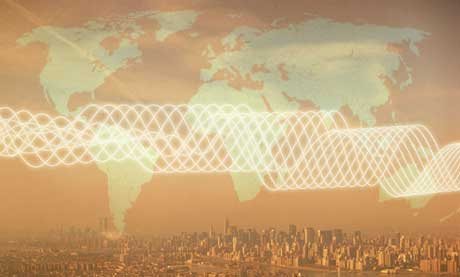The Impact of Climate Change
The Impact of Climate Change


Global climate change will bring about shifts in average weather patterns that will influence many aspects of our lives, including the quality of the air we breathe.But the computational problem of understanding how global climate change effects local pollution is huge.
Individual weather patterns are difficult to forecast more than a week in advance because it is impossible to measure all of the factors that may influence future trends—a classic example of a chaotic system.
An Emissions "Trap"
Typical air pollution episodes occur when warm air masses in the upper atmosphere stagnate over cold ones near the surface, eliminating any significant vertical exchange of mass or momentum.This traps emissions close to the ground and suppresses horizontal wind speed, compounding the buildup of pollutant concentrations. Depending on the temperature and cloud cover (which alters UV radiation), various chemical reactions transform primary emissions into the two chief components of photochemical "smog": ozone and airborne particulate matter (PM). Emissions themselves are relatively constant and day-to-day variability in air pollution is largely caused by variation in weather patterns.
Air pollution concentrations change quickly over relatively short spatial scales.For example, western Los Angeles typically experiences much different pollutant concentrations than their neighbors 50 to 100 km downwind to the east. Global climate models usually have spatial resolution of ~100 km, making it difficult to resolve changes in local weather patterns that influence air pollution events. Rather than waiting for increasing computational speed to make regional air pollution calculations practical within models, scientists and engineers around the world have chosen to "dynamically downscale" climate output using standalone regional weather and air pollution models.
Their predictions are used as initial and boundary conditions for a mesoscale meteorological model that can typically predict weather patterns with 4-5 km resolution. The meteorological model may also include a description of the regional air pollution chemistry or these calculations can be carried out with a standalone reactive chemical transport model developed for air pollution analysis. One of the most consistent results to date is the finding that climate change will encourage higher surface ozone concentrations in some regions of the United States, largely through the effects of temperature on precursor emissions and chemical reaction rates.
Impact on Particulate Matter
The effect of climate on PM has proven more challenging to understand than comparable studies for ozone. PM is composed of many different chemical compounds in solid or liquid form across sizes ranging from a few nano-meters to tens of microns (larger particles typically deposit quickly to the ground).Climate change simultaneously affects temperature, humidity, wind speed, cloud cover, and precipitation which all influence PM formation in different ways.The state-of-the-science predictions for climate effects on PM concentrations have downscaled multiple years of PM concentrations to < 10km spatial resolution in the present climate and the future climate with tremendous computational cost.
Though the computational burden is already high, much more work remains before we truly understand the impact of the climate on regional PM concentrations. Most studies use a single global climate model. But different models produce different estimates for future climate. Several models, with a variety of regional weather and air quality data, will need to be downscaled to develop a consensus about the effects of future climate on PM concentrations.For instance, the frequency of wildfires in some regions across the world is likely to increase, with dire consequences for nearby air quality. But wildfires themselves are random events that can only be studied in a stochastic sense over long averaging times—a truly monumental computing challenge that is just barely achievable using today’s technology.
Luckily, computational power continues to increase at a relatively constant cost every few years. Scientists and engineers with strong fundamental programming skills and cross cutting knowledge of computer science, atmospheric fluid dynamics, thermodynamics, and chemistry will have a better understanding of climate-air quality problems in the coming years.
[Adapted from "The Impacts of Global Climate Change on Regional Air Pollution" by Michael Kleeman, for ME Today.]
Air pollution concentrations change quickly over relatively short spatial scales.




